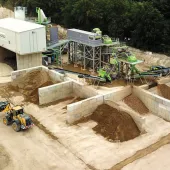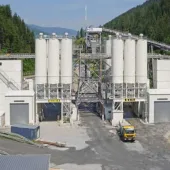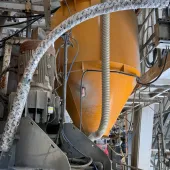Delivering ecological gain in the Colne Valley

HS2 aiming to reuse construction materials to create vast area of chalk grassland on the edge of the Chilterns
AN ambitious scheme, designed by HS2’s landscape architects, ecologists, engineers and soil specialists, aims to reuse construction materials – including limestone aggregate and concrete – to create 127ha of new chalk grassland, woodland, wood pasture and wetland habitats that will substantially enhance the local natural environment.
The Colne Valley Western Slopes project will be a major contributor in meeting HS2’s carbon-reduction targets by delivering significant ecological gain in the Colne Valley. It will also reduce the carbon footprint of the project by reducing road haulage and waste-treatment activities, and will allow habitats to sequester carbon by replacing arable land with natural habitats.
Plant species and habitats are being carefully selected to be resilient to a changing climate. Almost 65,000 trees and shrubs of 32 species will be planted together with nearly 3.5km of new hedgerows. Around 90ha of calcareous grasslands, which once thrived on the valley slopes, will be established and areas of historic woodland reinstated.
The project, being designed and delivered by HS2’s civils contractor Align, will also provide wider health and recreation benefits for neighbouring communities, including the provision of new connected green spaces and around 4.5km of new footpath, cycling and horse-riding routes.
Arable land that is initially needed for a major works compound to construct the Colne Valley Viaduct and Chilterns Tunnel will be transformed through the re-use of existing soils and recycling of 3 million cubic metres of chalk taken from the tunnel excavation, as well as concrete and limestone aggregate materials used in the construction process.
Reusing materials rather than transporting them away by road will significantly reduce carbon output. The excavated material will be used to re-establish the locally distinctive chalk valley landscape, replicate natural drainage flows and establish the right growing conditions for calcareous grassland across the site.
Calcareous grasslands, which develop on shallow soils overlying chalk or limestone, are a valuable, scarce and rapidly declining habitat in the UK, with this decline reflected in both the Colne Valley and adjacent Chiltern Hills. The neighbouring Chilterns Area of Outstanding Natural Beauty is currently thought to support around 700ha of chalk grassland. This collaborative project will provide a unique opportunity to create one of the largest extents of such habitat in this area.
New planting and seeding will create an extensive mosaic of habitat that will potentially be colonized by hundreds of species of flora and fauna, including invertebrates, birds, mammals, reptiles and amphibians.
HS2’s environment director, Peter Miller, said: ‘This project forms a major part of HS2’s Green Corridor programme to establish better-connected, sustainable and biodiverse landscapes along the route of the new railway that will contribute substantially to HS2’s carbon-reduction target.
‘It demonstrates HS2’s approach to addressing many of the complex issues surrounding climate change and which are central to protecting our environment, and is a great example of how good design and planning can mitigate the effects of climate change.’
Daniel Altier, project director with Align, said: ‘This innovative, multi-discipline project is designed to create a huge expanse of new grassland, connected woodland and wood pasture in the Colne Valley, helping to preserve declining or rare flora and fauna in the area, and providing a lasting legacy for biodiversity and local people.
‘We are pleased to be collaborating on the design with Natural England, Hertfordshire and Middlesex Wildlife Trust, the Colne Valley Regional Park Panel, local authorities, and specialist soils experts.’
Simon Railton, landscape architecture lead from the LDA Design/Jacobs team (on behalf of Align-D), said: ‘Our proposals are the result of a truly collaborative endeavour which has compelling landscape and ecological objectives at its centre. This is a rare opportunity to establish, at scale, a distinctive and multi-layered landscape, which is inspired by and grounded in the context of the Colne Valley and Chiltern Hills.
‘We aim to create a landscape which is both rich in biodiversity and a place for people to explore and connect with the natural environment. In doing this, we are embracing sustainable design solutions such as green travel opportunities and re-use of construction materials to help achieve ambitious carbon-reduction targets.
‘Our design team is passionate about achieving an enduring environmental legacy for the project and playing our part in addressing some the biggest issues of our time around climate change and biodiversity loss.’
Matt Hobbs, ecology lead from Jacobs (on behalf of Align-D), added: ‘The Colne Valley Western Slopes is a unique opportunity to give something back for wildlife by creating a large new reserve dedicated to nature in the Colne Valley. The design will deliver habitats that are the biggest and best possible, and those that will succeed and thrive over the long term with minimal human input.
‘We initially focused on soils and substrates, the essential building blocks for the habitats, and ensuring they are provided using site-won soils, chalk and temporary works materials. The key challenge is creating the necessary physical and chemical characteristics of the soil profiles to support resilient, biodiverse grasslands and the specialist species that thrive there. This is the subject of an innovative research study with Cranfield University and Tim O’Hare Associates that will involve both laboratory and field trials during construction to fine-tune the design.
‘A key challenge with habitat creation is how to establish and then maintain the habitats over the long term. The team’s approach uses local land managers who will let natural processes operate and introduce free-roaming livestock to graze the habitats year-round. This will reduce management inputs, increase soil health, soil carbon, and overall biodiversity, while creating a dynamic landscape of wood pasture and wetland over time. The designs include all the necessary infrastructure to support grazing animals year-round, including fencing, cattle grids, management areas and wetlands for watering.
‘Numerous small-scale features have been included to diversify the habitat further. These include s-shaped sparsely vegetated banks for reptiles and invertebrates, and hibernacula to provide refuges for reptiles and amphibians, as well as localized variations in topography to provide niches for many species to colonize.’
Align are currently preparing the site for the launch of the two tunnel-boring machines that will excavate the 16km long Chiltern Tunnels. Once launched in 2021, the site will receive a continuous supply of chalk until tunnel completion in 2024. Field trials are in preparation ahead of final seeding and planting of trees and shrubs in 2025.









